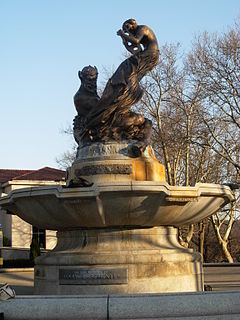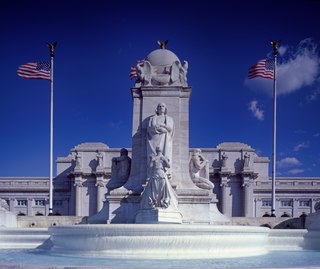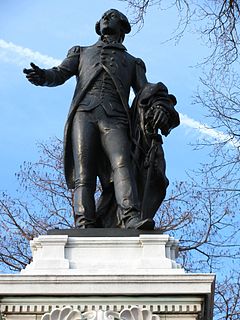
The Archibald Fountain, properly called the J. F. Archibald Memorial Fountain is located in Hyde Park, in central Sydney. It is named after J. F. Archibald, owner and editor of The Bulletin magazine, who bequeathed funds to have it built. Archibald specified that it must be designed by a French artist, both because of his great love of French culture and to commemorate the association of Australia and France in World War I. He wished Sydney to aspire to Parisian civic design and ornamentation. The artist chosen was François-Léon Sicard, who completed it in Paris in 1926 but never saw the sculpture be placed in Sydney, where it was unveiled on 14 March 1932 by the Lord Mayor of Sydney, Samuel Walder.

The National Gallery of Art, and its attached Sculpture Garden, is a national art museum in Washington, D.C., United States, located on the National Mall, between 3rd and 9th Streets, at Constitution Avenue NW. Open to the public and free of charge, the museum was privately established in 1937 for the American people by a joint resolution of the United States Congress. Andrew W. Mellon donated a substantial art collection and funds for construction. The core collection includes major works of art donated by Paul Mellon, Ailsa Mellon Bruce, Lessing J. Rosenwald, Samuel Henry Kress, Rush Harrison Kress, Peter Arrell Browne Widener, Joseph E. Widener, and Chester Dale. The Gallery's collection of paintings, drawings, prints, photographs, sculpture, medals, and decorative arts traces the development of Western Art from the Middle Ages to the present, including the only painting by Leonardo da Vinci in the Americas and the largest mobile created by Alexander Calder.

The World War II Memorial is a memorial of national significance dedicated to Americans who served in the armed forces and as civilians during World War II.

There are many outdoor sculptures in Washington, D.C. In addition to the capital's most famous monuments and memorials, many figures recognized as national heroes have been posthumously awarded with his or her own statue in a park or public square. Some figures appear on several statues: Abraham Lincoln, for example, has at least three likenesses, including those at the Lincoln Memorial, in Lincoln Park, and the old Superior Court of the District of Columbia. A number of international figures, such as Mohandas Gandhi, have also been immortalized with statues. The Statue of Freedom is a 19½-foot tall allegorical statue that rests atop the United States Capitol dome.

Walker Kirtland Hancock was an American sculptor and teacher. He created notable monumental sculptures, including the Pennsylvania Railroad World War II Memorial (1950–52) at 30th Street Station in Philadelphia, Pennsylvania, and the World War I Soldiers' Memorial (1936–38) in St. Louis, Missouri. He made major additions to the National Cathedral in Washington, DC, including Christ in Majesty (1972), the bas relief over the High Altar. Works by him are at the United States Military Academy, the Library of Congress, the United States Supreme Court Building, and the United States Capitol.

The TitanicMemorial is a granite statue in southwest Washington, D.C., that honors the men who gave their lives so that women and children might be saved during the RMS Titanic disaster. The thirteen-foot-tall figure is of a partly clad male figure with arms outstretched standing on a square base. The base is flanked by a square exedra, created by Henry Bacon, that encloses a small raised platform. The statue was erected by the Women's Titanic Memorial Association.

The Mary Schenley Memorial Fountain, also known as A Song to Nature, is a 1918 landmark public sculpture in bronze and granite by Victor David Brenner. It sits in Schenley Plaza at the entrance to Schenley Park and directly in front of the University of Pittsburgh's Frick Fine Arts Building in Pittsburgh, Pennsylvania, United States. The fountain is designated as a contributing property to the Schenley Farms Historic District.

Columbus Fountain also known as the Columbus Memorial is a public artwork by American sculptor Lorado Taft, located at Union Station in Washington, D.C., United States. A centerpiece of Columbus Circle, Columbus Fountain serves as a tribute to the explorer Christopher Columbus. The unveiling in 1912 was celebrated all over Washington, DC over the course of three days with parades, concerts and fireworks gathering tens of thousands of people from all over the world.

The Burnside Fountain is a non-functioning drinking fountain at the southeast corner of Worcester Common in Worcester, Massachusetts. It consists of two parts, a pink granite basin, and a bronze statue of a young boy riding a sea turtle. The basin was designed by architect Henry Bacon, who later designed the Lincoln Memorial in Washington, D.C., and the figure was created by sculptor Charles Y. Harvey. Harvey died by suicide before finishing the sculpture, and Sherry Fry completed the bronze. The Burnside Fountain was commissioned in 1905 by the city of Worcester after Harriet F. Burnside bequeathed US $5,000 to create a fountain to provide fresh water for people, horses and dogs, in the memory of her father, a prominent lawyer. The fountain was installed in 1912 in Central Square, then moved in 1969 to its current location on Worcester Common. In 1970 the statue was stolen, and was re-installed two years later. An attempted theft occurred in 2004.

The Daniel Webster Memorial is a monument in Washington, D.C. honoring U.S. statesman Daniel Webster. It is located near Webster's former home at 1603 Massachusetts Avenue Northwest, beside Scott Circle at the intersection of Massachusetts Avenue and Rhode Island Avenue.
Benjamin Franklin Ferguson was an American lumber merchant and co-founder of the Santee River Cypress Lumber Company. The firm specialized in the harvesting of old-growth timber from the blackwater river bottomlands of central South Carolina, in and around the Santee River watershed. The tracts of land logged by Ferguson, in partnership with fellow logging executive Francis Beidler, included substantial tracts of valuable bald cypress.

The Bartholdi Fountain is a monumental public fountain, designed by Frédéric Auguste Bartholdi, who later created the Statue of Liberty. The fountain was originally made for the 1876 Centennial Exposition in Philadelphia, Pennsylvania, and is now located at the corner of Independence Avenue and First Street, SW, in the United States Botanic Garden, on the grounds of the United States Capitol, in Washington D.C.

The George Gordon Meade Memorial, also known as the Meade Memorial or Major General George Gordon Meade, is a public artwork in Washington, D.C. honoring George Meade, a career military officer from Pennsylvania who is best known for defeating General Robert E. Lee at the Battle of Gettysburg. The monument is sited on the 300 block of Pennsylvania Avenue NW in front of the E. Barrett Prettyman United States Courthouse. It was originally located at Union Square, but was removed and placed in storage for fourteen years before being installed at its current location. The statue was sculpted by Charles Grafly, an educator and founder of the National Sculpture Society, and was a gift from the state of Pennsylvania. Prominent attendees at the dedication ceremony in 1927 included President Calvin Coolidge, Governor John Stuchell Fisher, Secretary of the Treasury Andrew W. Mellon, and Senator Simeon D. Fess.

Major General Marquis Gilbert de Lafayette is a statue in the southeast corner of Lafayette Square, in Washington, D.C., near the junction of Pennsylvania Avenue with Madison Place and close to the White House. The statue was erected in 1891 to honor Gilbert du Motier, Marquis de Lafayette and his contribution in the American Revolutionary War. The square, originally part of the President's Park, was named in honor of the Marquis in 1824. The statuary was made by Alexandre Falguière and Antonin Mercié, and the architect who designed the marble pedestal was Paul Pujol.

The Dupont Circle Fountain, formally known as the Rear Admiral Samuel Francis Dupont Memorial Fountain, is a fountain located in the center of Dupont Circle in Washington, D.C. It honors Rear Admiral Samuel Francis Du Pont, a prominent American naval officer and member of the Du Pont family. The fountain replaced a statue of Du Pont that was installed in 1884. Designed by Henry Bacon and sculpted by Daniel Chester French, the fountain was dedicated in 1921. Prominent guests at the dedication ceremony included First Lady Florence Harding, Secretary of War John W. Weeks and Secretary of the Navy Edwin Denby.

The statue of John Aaron Rawlins, a United States Army general who served during the Civil War and later as Secretary of War, is a focal point of Rawlins Park, a small public park in Washington, D.C.'s Foggy Bottom neighborhood. It was installed in 1874, but relocated several times between 1880 and 1931. The statue was sculpted by French-American artist Joseph A. Bailly, whose best known work is the statue of George Washington in front of Independence Hall in Philadelphia.

The Stephenson Grand Army of the Republic Memorial, also known as Dr. Benjamin F. Stephenson, is a public artwork in Washington, D.C. honoring Dr. Benjamin F. Stephenson, founder of the Grand Army of the Republic, a fraternal organization for Union veterans. The memorial is sited at Indiana Plaza, located at the intersection of 7th Street, Indiana Avenue, and Pennsylvania Avenue NW in the Penn Quarter neighborhood. The bronze figures were sculpted by J. Massey Rhind, a prominent 20th-century artist. Attendees at the 1909 dedication ceremony included President William Howard Taft, Senator William Warner, and hundreds of Union veterans.

The American Veterans Disabled for Life Memorial is a memorial in Washington, D.C., which honors veterans of the armed forces of the United States who were permanently disabled during the course of their national service. Congress adopted legislation establishing the memorial on October 23, 2000, authorizing the Disabled Veterans for Life Memorial Foundation to design, raise funds for, and construct the memorial. The fundraising goal was reached in mid-2010, and ground for the memorial broken on November 10, 2010. The memorial was dedicated by President Barack Obama on October 5, 2014.

The Zodiac settle is a piece of painted furniture designed by the English architect and designer William Burges and made between 1869 and 1871. A wooden settle designed with Zodiac themes, it was made for Burges' rooms at Buckingham Street, and later moved to the drawing room of The Tower House, the home that he designed for himself in Holland Park. Burges desired to fill his home with furniture "covered with paintings, both ornaments and subjects; it not only did its duty as furniture, but spoke and told a story." At one stage the poet John Betjeman gave the settle to the novelist Evelyn Waugh, and it is now in the collection of The Higgins Art Gallery & Museum in Bedford.



















